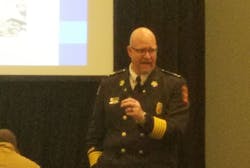FHExpo17: TN Fire Chief Tells Tale of Devastation
The recent devastation in Northern California has again proven the risks western states face from massive wildfires.
Significant fires such as those that have killed over 40 people in California's Wine Country are starting to feel like annual events, but what about when it happens in a region of the country where it's almost never expected?
The Great Smoky Mountains wildfires in late 2016 wreaked terror and havoc on Gatlinburg, TN, and its surrounding communities, resulting in 14 deaths and 134 injuries as well as costing well over $1 billion in insurance claims. In a span of only six to eight hours, over 2,500 structures burned to the ground on the night of Nov. 28, 2016.
"We kept asking ourselves, 'How could that happen?'" Gatlinburg Fire Chief Greg Miller said. "We had never seen anything like that in the Eastern United States. The fire was growing at around 2,000 acres an hour."
Chief Miller was at Firehouse Expo in Nashville last week and offered a heartfelt and harrowing account of an incident that decimated his scenic mountain town and popular tourist destination.
It began on Nov. 23 with two juveniles playing with matches along a mountain trail in the Great Smoky Mountains National Park and later became a smoldering and slowly building fire that park officials believed would be brought under control by crews within its borders.
And then after five days without any significant level of containment achieved, the swirling winds came and the fire quickly rolled down the mountain, creating what Miller called "an ember storm."
"Around 6 p.m. we had a high wind recorded in the park of 87 miles an hour," he said. "It was so high that it took out power in the park to the barometer that measures it. ... The next several hours after that, the winds were even greater -- we just had no way to physically record it. We had full-size dumpsters being pushed down the street that our apparatus had to drive around."
"It was the worst wind event that I have ever seen in my 27 years on the job. ... And everything that could go wrong did."
The ember-sparked fires spreading across his town would have been bad enough on their own, but the high winds also knocked down trees, which in turn knocked down power lines that started even more blazes. With power going down across the area, 911 communications were essentially gone and fire crews had a great deal of difficulty communicating with each other.
"It didn't take us long to realize that we were in above our heads."
Eventually, 50 counties and 225 agencies responded into and around Gatlinburg, bringing 450 pieces of apparatus and 3,500 first responders -- and that's not even counting the more than 1,000 firefighters requested by national park officials. There were also 224 members of the National Guard sent in.
Miller mentioned how pioneering Chief Alan Brunacini, who sadly passed away just before the Expo began, once said that an incident commander can be effective by simply relying on the information being given by his or her crews. Miller, however, said that what he was hearing from his firefighters was almost beyond his comprehension.
"That was one of the biggest challenges for me personally," he said. "I can't tell you how difficult it was to hear what they were saying and what they were seeing, and me not being being able to see because there are so many different scenes.
"To hear a captain and his crew come across the radio at a certain point and he orders his entire crew to come to the center of a parking lot, get face down and pray because it's getting ready to come over their heads. And then three or four minutes of radio silence. Imagine that. And then the most heavenly sound when the radio chirped to life again and everyone called out that they were OK."
Miller said it was a continuous roller coaster of emotion because things like that kept happening "again and again and again." One of Miller's firefighters eventually told him he was glad the chief couldn't see where he was sending his crews because if he could, "'You wouldn't have sent us.'"
The frantic six to eight hours when things were at their worst eventually yielded to what Miller could only describe as a "Godsend."
"And then at 2 a.m., the wind stopped like you had turned off a switch," he said. "And the rains came. Good, soaking, heavy rains. We had prayed for this for hours and it finally arrived. There were no new structure fires after that point."
Work on the fires continued for days and the blazes were finally under control by Dec. 9. Around 14,000 people were evacuated from the area, but Miller offered a sobering thought considering the timing of the event. Nov. 28 was the Monday after Thanksgiving weekend last year.
"If this would have happened three days sooner ... Thanksgiving weekend is one of our busiest tourist weekends. There were around 14,000 to 18,000 people in town on Monday when the fires came into town. Had it been on Saturday, it would have been around 70,000 to 80,000."
Miller closed his talk with details about the aftermath, specifically the gigantic outpouring of donations and the millions raised to help the town and those affected by the fires, which were the worst in the Eastern U.S. since 16 people were killed in Maine during the Great Fires of 1947.
"I told my boss when this was over that we have a debt of gratitude to pay," Miller then said of the firefighters who came to help in his town, some of whom were in attendance at the talk and received a rousing round of applause when Miller asked them to stand and be recognized. "Firefighters take care of each other. Whenever you need us, give us a call."
